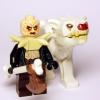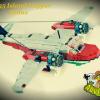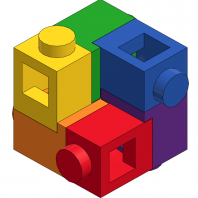Search the Community
Showing results for tags 'aircraft'.
Found 79 results
-
According to Brick Clicker the next LEGO Icons set will be a scale model of the Concorde. Set nr.: 10318 Nr. of pieces: 2083 Price: 199.99$ Release date: September 4th Licensed: Yes (Airbus) Length on stand: 102cm / 40in Dimensions: 105 cm x 43 cm x 15 cm Scale: 1:60 Lead Designer: Milan Madge Stickers: none
-
Hi all, (I don't really know where to put this - "Special Themes" or "Scale Modeling" - so if it's wrong here, please let me know... ) LEGO’s new Concorde is a fine set overall, but it has, in my opinion, some flaws which compromise its looks.So I had to decide whether to modify it or to build something different… and, as I prefer the more "brutal" appearance of the Concorde’s Soviet counterpart anyway, I chose the latter. The prototype The Tu-144 was the first commercial supersonic aircraft, its maiden flight taking place two months before the Concorde took off. Nevertheless, the Tu-144 is often regarded as much inferior to the Concorde, but that’s not the full story. Commercial passenger flights were only offered for a few months, that's true, but it was due to changing political circumstances rather than for technical reasons that the Tu-144 was finally withdrawn from passenger service. Indeed there were some technical issues (as perhaps with every completely new aircraft), but they most probably would have been solved had not the Soviet authorities lost interest in supersonic commercial aviation and thus ordered not only commercial flights, but the whole development programme to be terminated in 1983. And yet, while the first production variant Tu-144S was hampered by its inefficient Kuznetsov engines, the improved Tu-144D version (with Kolesov engines) had performance figures almost on par with the Concorde. Consequently, it was a Tu-144D (CCCP-77114, disguised as "aircraft 101" for unclear reasons) that set 13 official world records for speed and altitude with given payloads in July 1983, just after the cancellation of the Tu-144 programme had been announced. (For those of you who have a deeper interest in this matter: Yefim Gordon, Dimitriy Komissarov, Vladimir Rigmant - Tupolev Tu-144, The Soviet Supersonic Airliner. A very good reading about the Tu-114’s design, development and the political affairs behind it) The model To celebrate the 40th anniversary of its above-mentioned flights, my model bears the registration and "101" titles of the world record plane. I was originally motivated to design it by ungern 666’s Tu-144 sketch on Rebrickable, but, apart from some inspirations I took regarding the tail section, it has evolved into a completely different scale model. The plane consists of approx. 1900 parts an weighs ca. 1.3 kg. The "droop nose“, canards, rudders (yes, two) and elevons are moveable. While the landing gear is not retractable (I prefer a true-to-scale look over functions), it can be replaced with parts for the closed landing gear bay doors. Also, the tail cone can be replaced with a sub-model assembly showing the deployed brake parachutes. Unfortunately, at the moment there's only one photo of the completed model, which has a crudely photoshopped grey background. More pictures will follow as soon as I have found a sufficiently large, neutral, real background... Thanks for stopping by! Kind regards, Sven
- 21 replies
-
- scale model
- airplane
-
(and 8 more)
Tagged with:
-

[MOC] CityAirbus Air Taxi
Brickthus posted a topic in LEGO Technic, Mindstorms, Model Team and Scale Modeling
Following my disappointment that the Osprey 42113 did not follow the normal pattern of availability and cost, I decided to build a civil aircraft MOC of a similar price point. I chose the CityAirbus because it has an interesting configuration, not seen before in LEGO Technic. The real one is all-electric, improving on the usual gas-guzzling Technic prototypes. There was also room to innovate in the model. A lot of prototype aircraft inherit a shell from an existing one and fit new equipment, which doesn't make for such an interesting model. With Technic we want to see the new mechanisms, so I left the underside open to view the gearbox. There are three motorised functions: rotor spin, a "hovering" mechanism and a movement mechanism. A single L-motor powers the 8 rotors and a selection gearbox for the other 2 functions. The right lever does the hovering mechanism, which lowers a pair of linear actuators that move clear beams to raise the aircraft off the ground. The left lever does the movement mechanism that powers a sliding axle arrangement that drives clear wheels on the feet of the scissor jack. The two manual "mechanisms" are removal of panels on each side and the ability to rolls sideways when landed, using small wheels on the skids. The red lever sows the centre of the function selection gearbox. It works like the one on the back of Claas tractor 42054. The rotor drive comes from the centre of the gearbox, using the reversing bevels, and goes up, then diagonally to reach the front rotors. The rear rotor drive goes along the top. My first prototype test model allowed the rotors to tilt in sided pairs but they do not do so in the real CityAirbus. The motor is above and to the rear of the function gearbox. The hovering mechanism is geared down by worm but has a small gear-up before the worm. A clutch protects the motor. You can see the final drive from the end of a row of 16-tooth cogs to the LA (mirrored the other side). The movement mechanism has an axle sliding in a red 8-tooth cog in between the LAs, with bevel drives to the wheels. The battery unit (any 4x8x3 one will do) is housed at the rear. The 12-tooth cog shows the control to a PF LiPo for this prototype but the PU 2-port hub could be used. The maximum hovering height is about 7cm but the movement function works as soon as the skids have left the ground. Further flight uses the traditional "swooshing" method. Walking pace would meet the real 75mph design speed at 1:20 scale! My hope is that this will help to ensure that we have LEGO Technic civil aircraft of a decent size in the range of sets, seeing as the Osprey would have been around for at least next year, had it not tripped over the "non-military" policy. As a set, the final CityAirbus model would need to be sponsored by Airbus Helicopters, who own the IP to the real CityAirbus. They would specify decals to put the livery patterns and brand names on it. The design and build time was 125 hours over about 5 weeks in August and September, quite a few hours after midnight! More pictures in my Brickshelf folder Video on YouTube Project on LEGO Ideas Please let me know what you think, and do support and share! Thanks, Mark- 6 replies
-
- helicopter
- airbus
-
(and 2 more)
Tagged with:
-
vintage airliner - Douglas DC-3 in Trans World Airlines (TWA) colors - 7628-inspired MOC - finished 7/14/23
Murdoch17 posted a topic in LEGO Town
Back in the day, whilst flying you could get a real turkey carved right in front of you, stretch your legs without bothering your neighbor in front of you, and take whatever you wanted on board with you... peanut butter, toothpaste, shampoo, you name it! Need the smoking section? The whole freaking plane was the smoking section! Of course, tower radar wasn't really a thing (cockpit radar was a long way off too), flight instruments were crude, and inflight entertainment was either out your window, napping, or reading whatever book you brought with you. Crashes were also common with survivability rates poor, and there was no GPS to guide your pilot on his way.... but they did have paper maps, gut instinct, a lot of know-how and nerves of steel. (a quick silent prayer couldn't hurt either) So, buckle those seatbelts (if your plane has any!) and steady those pre-flight jitters - we're taking off! This 1936-designed Douglas Aircraft Company DC-3 was very heavily modified from limited edition Indiana Jones set 7628 (Peril in Peru, from the Kingdom of the Crystal Skull film) and my own imagination. I redesigned the passenger cabin of the DC-3 to not have any pesky stickers as in the 2008 set. Sadly, the airplane's opening door has been removed as a consequence of redesigning the airframe. The colors are based off Trans-World Airlines (otherwise known as TWA) back in the immediately post-WWII period. It's not a perfect match for the paint scheme, but it doesn't use stickers, so I'm happy. The rear of the plane. Originally I wanted to build this airplane in green for Ozark Air Lines, but limited green wedge part availability killed that idea. (Ozark was headquartered at my local major airfield - St. Louis' Lambert Airport, from the early '50's until when they merged with TWA in 1986) The two front landing gear fold up. The roof of both cabin and cockpit come off to seat six passengers and one pilot figure. Thoughts? EDIT 7/14/23: Main post updated, model finished!- 6 replies
-
- douglas aircraft company
- set mod
- (and 12 more)
-
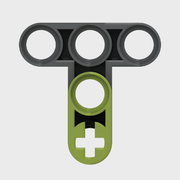
42152 Conwing L-16 Cargo Seaplane - alternate build
Timorzelorzworz posted a topic in LEGO Technic, Mindstorms, Model Team and Scale Modeling
Hi folks, I want to share a new creation. Rebuild your Lego Technic 42152 Firefighter Aircraft into this Conwing L-16 Cargo Seaplane alias "Seaduck" from the famous cartoon Talespin. This model is an alternate build, meaning all 926 required parts comes from the main set with no extra parts needed. The plane uses 4 spare parts, that are all available with the set 42152 Firefighter Aircraft with a total parts count of 930. Get ready to join the Higher for Hire Cargo Company with its pilot Baloo von Bruinwald XIII, to rebuild one of the most iconic planes in cartoon history. You can find instructions here if you are interested in building this model. Features & Functions fast spinning propeller in opposite direction working rudder on wings openable cargo bay with linear actuator dual-linkage mechanism for cargo doors implemented wheels for comfortable playing includes two offshore buoys measures 40x46x12cm Impressions Propeller & rudder Propeller for that seaplane are custom made to fit the scale of this alternate build. Both propeller are geared up as much as possible, spinning very fast but smoothly in opposite direction by turning the red gear on top. I was not happy about the rudder implementation for the Firefighter Aircraft donor set. As a result, the rudder on wings are operable in a more comfortable way for this model. Cargo bay & doors To be confirm with the Higher for Hire Cargo Company, this Conwing L-16 is made to transport freight, providing as much space in the back as possible. By controlling the black gear behind the nose, a linear actuator is triggering a sliding mechanism to open the cargo doors. This mechanism opens the cargo door itself and part of the roof simultaneously, providing more room to reveal the cargo bay. The following animation should help to understand how the dual-linkage mechanism for the cargo doors works: Floating over surfaces This model is made as a seaplane only with no retractable landing gears, due the fact that the linkage mechanism inside takes up almost all the space. Thanks to the implemented wheels, the plane floats very smoothly over each surface to ensure a good playability. Of course this Conwing L-16 is a construction toy, do not put it into water. This model does not really float on water, but on its wheels instead. The seaplane has a heavy back wing like the real one, performing a take-off when displaying the model. Instructions Premium instructions for this alternate build comes in a single PDF-file with 241 pages of high quality building steps and clear images to ensure a satisfying building experience. Builders will be surprised what clever techniques and tricks are used to form all the shapes of the model, especially for the iconic red nose. Go back to the basics of Lego Technic with common colors, cool functions and playability - not only for the younger audience of builders. You can find instructions here. Seaduck from Talespin Talespin is a trademark of Disney and freely used to reference this model. Have fun with this 42152 Conwing L-16 "Seaduck" Cargo Seaplane alternate build.- 7 replies
-
- alternate build
- alternate
- (and 5 more)
-
Hello everyone! I'm here on the Action and Adventure forum today to share with you my latest creation: 5935 Island Hopper Redux! 5935 Island Hopper redux by Joshua, on Flickr 5935 Island Hopper redux flying by Joshua, on Flickr 5935 Island Hopper redux wheels down by Joshua, on Flickr 5935 Island Hopper redux interior by Joshua, on Flickr ----------------------------------------------------------------------------------------------------- 5935 Island Hopper was one of my favorite sets TLG ever put out. I have many happy memories from my youth of long hours spent lost in the world of Johnny Thunder, and this set was always my favorite to play with, and somehow always made it into every adventure, no matter what environment it was taking place in. Sadly I no longer have the original set still complete, but recently I came across the instructions, and decided it was time for this to be reborn with new parts and techniques. All the play features from the original set are there, such as folding wings, and removable roof, but I also added a few of my own, namely retractable landing gear, opening rear hatch,full interior, and working vertical and horizontal stabilizers. Worth noting is that many of the pieces from the original set were used in the new model. Hope you all like it! Long Live Johnny Thunder! Cheers, Joshua
- 14 replies
-
- Island Hopper
- aircraft
-
(and 4 more)
Tagged with:
-
Hi all, this is a first aircraft, a Canadair CL-215 waterbomber in minifig scale (around 1:45). Its wingspan is 80 studs, the fuselage is 8 studs wide. The main points were getting the wings straight and getting a smooth fuselage, especially at the rear. Apart from that it was quite a fun build, although it took nearly two months. Being a complete newbie in building airplanes I was very glad to see that I had some predecessors. It helped me a lot to look at their versions of the Canadair. That's why there are quite a few credits: John Lamarck, Bombardier CL-415: measurements, proportions, wing profile vincez01, Canadair CL-215: fuselage, landing gear Zorko Huljic, Canadair CL-415: tail Last not least a big thank to my dear friend Steffen, a LEGO plane specialist, who gave me a lot of advice. Take a look at his fantastic aircraft: www.flickr.com/photos/29666619@N04 Some more pics: Side view: The plane fits two whole minifig pilots, as you can see here: Furthermore the aircraft has some functions: 2 engines (run by a PF M motor each) flaps (run by a PF M motor) movable rudder, coupled with the steerable nose wheel Video (sorry for the bad quality, it's just to get an impression): The plane was built to be moved by an LCS (see http://www.eurobrick...showtopic=91937). It was quite suspenseful to see if a plane with a weight of over 1 kilogramme could be pulled by it. In fact it's no problem, as you can see here: This is quite nice because like this an airport with taxiing planes is possible which widens the possibilities when planning a town layout. That's about it so far, some more pics on Flickr, if you're interested in this. C&C welcome as usual, thanks for looking.
-

[TC15] Boeing Stearman Kaydet PT-17
braker23 posted a topic in LEGO Technic, Mindstorms, Model Team and Scale Modeling
From the first time I saw the theme for this Lego Technic contest, I was intrigued by it and wanted to give it a try, but it had to be a biplane. I have a soft spot for these aircrafts, after seeing them in many documentaries and old Hollywood movies. And after some time on the world wide web, I was hooked on the striking blue/yellow color combination on the Boeing Stearman Model 75. It's basically a military trainer aircraft built starting from 1934, in the United States. More than 10k were built until 1940, and after the WWII, they were sold to civilians. This was a great move, cause they were used as crop dusters, then as sport and acrobatic planes used in air shows. Around 1500 are still in use today, and many are at display in museums around the world. But enough of this, you can read more about it and see real photos on Wikipedia: https://en.wikipedia.org/wiki/Boeing-Stearman_Model_75 I tried my best to replicate the sleek lines of this marvelous biplane, while including relevant functions, such as: Functions: - motorized rotor - working ailerons (front) - working elevators (back) - functional tail rudder Technical Specs: Scale: 1:19 Weight: 956g Lenght: 46cm Wing span: 52cm Height: 18cm As the model is finished, see some representative photos here: So guys, I managed to get the stickers on, so here is the final model: See more detailed photos on my Flickr account: https://www.flickr.com/photos/braker23/albums/72157705259798851/with/46179286365/ Video is done and online, let me know what you think about functions: Thank you all for your time! -
Hi everyone, This is my P-51 Mustang Racing MOC. It is made out of 401 official LEGO pieces. Blue Bull is 28.7 centimeters long (11.3 inches), its wingspan is 30.7 centimeters (12.1 inches), it weighs 263 grams (9.3 ounces) and its top speed is just over 400 km/h (over 250 mph)! A single pilot can sit in the comfortable cockpit and take control of the plane any time. Although Blue Bull has an aerodynamic design, its mainframe’s strength is not compromised! The model is designed with agility, durability and playability in mind, so in case of an accident, the plane is sturdy enough to withstand any drop from the height of up to 30 centimeters (12 inches), without any part breaking off. The model can be easily and carelessly swooshed by holding any part – main body, nose, wings, tail or even the propeller. Plane’s nose, wings and tail are connected at a slight angle. Sideways and top-down building techniques are implemented to achieve the appropriate design of the nose and tail. Nose has a smooth narrowing shape towards the propeller, while tail also narrows towards the endpoint. Main wings also have a slanted design – rear line of the main wings is angled in two points, contributing to the overall appealing shape and leaving enough room for the front landing gear. Front landing gear can be deployed or retracted, but rear landing gear is fixed. If you like the plane and would like to see more photos, visit my Flickr album. And if you especially like the model, consider supporting it on Ideas, under a title "Blue Bull"!
- 7 replies
-
- plane
- stunt plane
- (and 14 more)
-
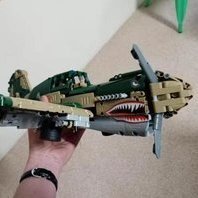
Curtiss P-40E Flying Tigers
roeltheworld posted a topic in LEGO Technic, Mindstorms, Model Team and Scale Modeling
Dear all, I'd like to show a MOC I finished last month: the Curtiss P-40E Tomahawk in the colours of the Flying Tigers in China. Tiger_11_wheelup by Roel Cruijff, on Flickr As you can see it's in dark green and khaki; colours which aren't readily available in LEGO sets. I had to order these bricks from CADA and wherever I could find them, so I hope I am not violating any rules there since these bricks are not from LEGO. Still, I don't regret it as my 'original' colour-vomit set made from mostly 42039 pieces just didn't have the right look to it: spareparts by Roel Cruijff, on Flickr It started innocent enough, with me making the front cowl and canopy... but you know the feeling, once you are that far it becomes a life mission and needs to be finished. halfway by Roel Cruijff, on Flickr At first the canopy could open, but I had to let that idea go when the controls were added. canopy by Roel Cruijff, on Flickr Really happy with the dihedral there. I used some black 15-length liftarms, which I have not been able to take out and switch to light grey. dihedral1 by Roel Cruijff, on Flickr Once the model was fairly complete, I ordered the various green and khaki parts, and came up with this: Blank_08_topview by Roel Cruijff, on Flickr Blank_03_sideview by Roel Cruijff, on Flickr Blank_05_bottomview by Roel Cruijff, on Flickr The flaps fell off right after I took this photo, so I fortified them since. They are controlled with a level in the cockpit, but I like the way they slope in down position: Blank_07_frontview by Roel Cruijff, on Flickr The flight surfaces are controllable by a small joystick behind the cockpit. It was very hard fitting the mechanisms in there, and I am afraid to take it apart for a picture as it'll be a challenge to put it back again. Tiger_12_controls by Roel Cruijff, on Flickr I am most proud of the landing gear retraction system. As you may know, the gears of a P-40 retract one after the other, so I always wanted to make it fully manual operation. Here below you can see how it works. You turn the small black cog to drive the linear actuator. this will push the gear axle back and forwards. A fixed cog at the base drives the wheel axle, and the 90 degree turn becomes a 90 degree twist, making the wheels fold neatly under the wings: Blank_13_wheelhalf by Roel Cruijff, on Flickr Blank_12_wheelturn by Roel Cruijff, on Flickr Here is the mechanism in case you'd like to try it: https://www.mediafire.com/file/fqgxwfmazzuclv0/Gear_retracting_mech.io/file The decals are simply laminated colour prints stuck with double sided tape. Works like a charm. Hope you like it and that it may inspire more WW2 aviation models! -
On Erotema homeland, the Supreme Leader Paul Ratchurch, Ministry of Defence N´Dongo and Ire Nemountain are visiting the first model of the newly developed SU 25 frogfoot. This is a jet-powered for close air support, being a step ahead from the Picarón Mk2 (inspired on the Argentinian Pucará). It has 11 hardpoints (5 per wing and 1 in the belly) and can carry up to 5 tonnes. This pictures show a wide selection of weapons, with two of them I am particularly proud of: the 30-mm anti tank cannon, inspired on the Ju 87 G anti tank Stuka, and the 8-barreled 12,70x108 machine gun, nicknamed "Little Irina". Not very suitable for highly armoured targets, but will cause havoc on unprotected troops and vehicles, as well as BOS terrorists (including civilians who support them). 20210501_095032 by green helmet spanish AFOL, en Flickr 20210501_095103 by green helmet spanish AFOL, en Flickr 20210501_095200 by green helmet spanish AFOL, en Flickr -Good morning from EADS testing ground, this is Tonoff Stonemanoff reporting from the only TV channel in Erotema, on "Allo Supreme Leader". He is here visiting the facilities. 20210501_095808 by green helmet spanish AFOL, en Flickr -Supreme Leader, it is our pleasure to hear you speaking. What´s your opinion about this glorius artifact made by the brightest minds in Erotema? 20210501_095851 by green helmet spanish AFOL, en Flickr -This will give us the chance to break fascism, terrorist, anticommunism, the PSIC, the BOS, anti-veganists, bullfights supporters, members of the resistance, all of them. -Oh, Supreme Leader, your words inspire all of us. Later, Paul and Ire go and see a "Little Irina"... 20210501_095909 by green helmet spanish AFOL, en Flickr -It is not large enough, I will have some of the technicians sentenced to force labour. -Oh Supreme Leader, you always so munificent...
-
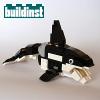
[C-model] 42105 - Pontoon Helicopter
Tomik posted a topic in LEGO Technic, Mindstorms, Model Team and Scale Modeling
This helicopter is my first alternative model built out of set 42105 (Catamaran). It features crank that spins both rotor blades and pontoons that gives it ability to float on water (although I didn't try it, it should work). I will be happy if anyone test its floating capabilities and share her or his experience in comments. Building instructions are available at buildinst.cz- 3 replies
-
- aircraft
- alternative model
-
(and 1 more)
Tagged with:
-
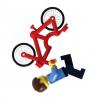
[42125 Alternate] Helicopter
paave posted a topic in LEGO Technic, Mindstorms, Model Team and Scale Modeling
Since the 42125 Ferrari set has blades... The features are: - Rotating propellers - Collective pitch control - Folding blades Video: More photos: Rebrickable page: https://rebrickable.com/mocs/MOC-68779/paave/helicopter/#details-
- 42125
- helicopter
-
(and 2 more)
Tagged with:
-
A while ago I created a small minifigure scale plane inspired by the classic Cessna 172. I built an ordinary version as well as a seaplane. You can check out a 3D-view on Mecabricks and I also created custom instructions which you can find on Rebrickable.
-

MOC: Display stand with adjustable angle for medium sized aircrafts
Pentomind posted a topic in Special LEGO Themes
Hello ! For my first topic here I would like to share with you a small thing I made that proved itself very useful ! I've had my 31039 sitting at the top of a 2 meters high shelf for a few month now and all I could see all day was the underneath of it. I was quite sad of this because I love this set and it's a very displayable model so I decided to work on a stand to display it. I wanted it to be : - As light as possible - Easy to use with any model - Made of common parts (actually the few parts I had left available) - And most important with ADJUSTABLE TILT ANGLE so I can modify the model position depending of how high the model is displayed. Here is the result : The stand is very sturdy and can handle a quite heavy model as long as it is well balanced on the stand. The model connects thanks to two 1x4 Technic bricks joined by a 2x4 plate : The parts are quite common and the rarest of them is the black 24T (I wanted the stand as black as possible ) Here are some pictures of the stand with the model on display : I also tested it with the 75102 and 75175 and both worked fine with the stand ! I think it can be easily modified to display technic models by replacing the technic bricks with Beams. I hope you will enjoy this stand, feel free to ask any question or suggest any improvement ! Oh and here is what it looks like on display at the top of the shelf : -
Hi all, This is my latest moc, the Red Wasp Stealth VTOL. You may hear it landing but you won’t see it coming! This one came together remarkably quickly from an initial idea I had a couple of weeks ago. It looks like a pretty simple build due to its clean outer shell but actually proved to be quite complex to create, particularly the rotor blade engines, which needed axles running deep into the body of each to support their weight and which also freely spin and adjust between flight and hover mode. For anyone interested, the full album can be found on my Flickr page here: https://www.flickr.com/photos/164260086@N06/albums/72157717218068297 Thanks for looking.
-
I recently finished building a LEGO City/Minifig scale plane that offers more details than your usual airliner. I have submitted my creation on LEGO Ideas. See more pictures and vote for it here! My model also has its own display stand which can also be used to display the minifigs. This plane is built using brick-built solutions instead of relying too much on pre-fabricated plane pieces. This plane has quite a nice cabin on the inside and can accommodate many minifigures. To see pictures of the Economy AND Business class cabins, please see my LEGO IDEAS project page.
-
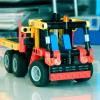
Flaperons [IDEAS]
captainmib posted a topic in LEGO Technic, Mindstorms, Model Team and Scale Modeling
Flaperons are a combination of flaps and ailerons, found on various airplanes. https://en.wikipedia.org/wiki/Flaperon Thanks to @MinusAndy and @Jeroen Ottens for sparking this topic. I've had the following idea for ages, but it can use some perfection. (I think I've borrowed this idea somewhere) Red - Input for flaps Yellow + Turntable - Input for ailerons Combined - Flaperons Please post your ideas, suggestions, or questions in this topic. -
Let me turn aside from cars and trucks and present you the Autogyro: Autogyro/gyroplane/gyrocopter is a vehicle, which contains both helicopter and plane qualities. As a helicopter, it has main rotor, making a gyro get off the ground. At the rear an engine-powered propeller pulls the vehicle horizontally, like a plane. The primary feature of autogyro is autorotation. Autorotation makes the main rotor rotate through air flows only. It does not need an additional power source; some models have pre-rotator, though. This is an ultralight autogyro, so, despite its look, it is finished. Video: Features & Functions: – Spinning rotor and propeller – Rolling wheels – Main rotor control with the joystick – Rudder control through pedals – Fake flat-2 engine – Dashboard – Seat belt. Measures: 27x14x21cm (blades diameter – 50cm). Weight: 150g. Autogyro isn't a common type of vehicle. I personally met it once while watching the second part of Mad Max trilogy, and I was astonished by its unusual look. Anyway I didn't try to copy it or any other specific copter. The presented one a collaboration of many.
-
Hi, all my friends here! I just posted a contribution on Lego Ideas. That's a cute and creative Lego jet- plane set. Check it out! If you like it, please support it on the official Lego Ideas website https://ideas.lego.com/projects/8f441604-87c1-4768-a5d7-cad0c014fb6a to help me make it real. For getting this set actually into the Lego market, I need to gather at least 10,000 supports. Thank you for your interest and support, and don't forget to share it to your friends!
-

[C-model] 42106 - Pullback Plane
Tomik posted a topic in LEGO Technic, Mindstorms, Model Team and Scale Modeling
I haven't been building any plane from LEGO Technic for a long time so I decided to build new one. I built it from set 42106 and it became my first twin propeller plane and also the first plane with pullback motor. Pullback motor is connected to both landing gear and propellers so after pulling it back you can let it run forward or lift it and let propellers spin during flight. Building instructions are available at buildinst.cz Any comments are welcomed.- 6 replies
-
- technic
- alternative model
-
(and 2 more)
Tagged with:
-
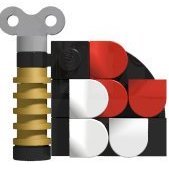
[MOC] Concorde (Air France/British Airways)
DoubleBU posted a topic in LEGO Technic, Mindstorms, Model Team and Scale Modeling
I was looking for LEGO Concorde designs but not very much came up in such a small scale so I thought I might as well give it a try. It comes complete with bendable nose cone, retractable landing gears (front and back), moveable back wing flaps (thanks again, mini fig pants...!) and the optional flame FX for... historical accuracy... . . .!? And as always you can find more pics here and if interested in a cutesy little Concorde to swoosh around the full set & instructions are available here. I hope you like my small sized interpretation of one of aviation history's most iconic aircraft. Thanks & have fun! (And many thanks to ukbajadave for explaining to a noob how to implement more pics here!) -
Hello everybody, Here's my lastest project, a minifig scale replica of the famous Canadian waterbomber, the Bombardier Canadair CL-415. First of all, I'd like to credit and thanks @ER0L. His great CL-215 model has provided me a lot of inspiration, especially for the nose and the tail building technique. Even if I'm far from the complexity he achieved with the Power Functions integration, I'm still quite happy with my build. I tried to reproduce as many details as possible, and I'm still working on others details:) For the moment, it includes: Flaps and ailerons mechanism Cockpit and interior (water and additives tanks) Right now, I'm working on the retractable landing gear system, and on improving the Pratt & Whitney engine design. The model is 50cm long and 65cm wide. I hope you'll like it! Tom
-
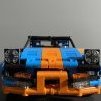
[MOD]Douglas SBD Dauntless
falconluan posted a topic in LEGO Technic, Mindstorms, Model Team and Scale Modeling
After watching the 2019 "Midway" movie, I tried to build a technic version of SBD Dauntless. I wanted this project to be a light and quick one, so I decided not to build the plane from scratch, instead, I wanted to mod from some exist MOCs. Then I found this master piece plane MOC on RB: https://www.eurobricks.com/forum/index.php?/forums/topic/150206-aircraft-fighter-bomber-mkii-lego-technic/&tab=comments#comment-2791893 https://rebrickable.com/mocs/MOC-9602/NikolayZubov/aircraft-fighter-bomber-mkii-lego-technic/#comments It's @Nikolay's wonderful fighter bomber MK II, a beautiful fictional plane packed with tons of features. This MOC has more than enough features I want to add to my SBD, so I removed some of them and adjusted the shape of the plane to make it look like a SBD of course, and here is the result: Featurewise it has(left over from original): Control surfaces controlled from cockpit: Ailerons Flaps (Unfortunately, it doesn't have any of the SBD's famous giant speed brakes) Elevators Rudder, connected directly to the tail wheel Other functions: Retractable landing gear; Wing folding mechanism, I know real SBD can't fold its wings, I keep this function to save space.... Rear machine gun Central retractable bomb pylon Sliding openable cockpit Some details: The olive green parts introduced by 42110 fits very well as the interior color here. The white belly: A closer look at the bomb: For paintjob , I chose the SBD-5's typical paintjob instead of the SBD-3 which appears in the movie. Some comparison with real SBDs: In memory of the already dissembled prototype: More pictures Thanks for watching, hope you like it. Many thanks again to the original MOC author: @Nikolay

